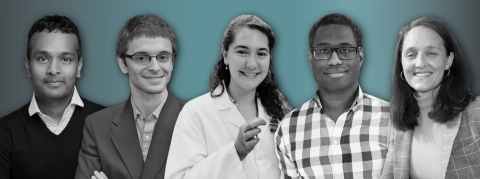Fellowship honors Silicon Valley pioneer and Intel co-founder, Gordon Moore
Today, the Gordon and Betty Moore Foundation named five fellows who will each receive $825,000 to further the development of new tools and technologies that promise to accelerate progress in the foundation’s areas of interest: scientific discovery, environmental conservation and patient care. The fellowships honor our visionary co-founder, Gordon Moore.
This press release features multimedia. View the full release here: https://www.businesswire.com/news/home/20211004005067/en/

2021 Moore Inventor Fellows (Photo: Business Wire)
The 2021 Moore Inventor Fellows are:
- Gozde Durmus, Ph.D., Stanford University School of Medicine
- Shyam Gollakota, Ph.D., University of Washington
- Marta Hatzell, Ph.D., Georgia Institute of Technology
- Max Shulaker, Ph.D., Massachusetts Institute of Technology
- David Van Valen, M.D., Ph.D., Caltech
“Bold ideas can change the world,” said Harvey V. Fineberg, M.D., Ph.D. “These young inventors have compelling projects that, if successful, will make a real difference. Providing them with the time and resources they need to pursue these aims is a great investment in the future.”
While their backgrounds and fields vary, the five fellows share a common passion for transformative ideas. The new cohort propose creating a portable laboratory platform to measure antibiotic sensitivity in harmful microbes; small-scale deployable wireless sensors to detect conservation challenges; a system to convert air into a liquid ammonia-based fertilizer; an electronic chip to improve hospital diagnoses; and new methods to track multi-color spatial patterns in living cells.
The $825,000 award supporting these projects includes $675,000 over three years from the foundation and $50,000 per year from their home institution. The inventors will also become part of a network of other awardees and will receive additional guidance from Activate.org, which helps bridge the gap between laboratory research and the market.
“We cannot know in advance that an invention we support will change the world,” said Robert Kirshner, Ph.D., chief program officer for science at the Moore Foundation. “Yet these inventors and their ideas show great promise in areas our foundation supports.”
Launched in 2016 to celebrate the fiftieth anniversary of Moore’s Law, the revolutionary prediction that anticipated the exponential growth of computing power, the fellowship embraces the spirit of Gordon Moore’s passion for science and honors his penchant for inventing. To nurture the next generation of scientist-inventors, the foundation plans to name a total of fifty Moore Inventor Fellows – five fellows per year for ten years – allocating nearly $34 million to their innovative projects.
This year, the foundation received nearly 200 nominations from 123 eligible institutions. In addition to the five selected fellows, five additional finalists received $25,000 each. Nominations for the seventh cohort to be announced in 2022 are open through December 13, 2021. To determine eligibility and learn more about the application process, please visit moore.org/inventors or email inventors@moore.org.
Gozde Durmus, Ph.D., Stanford University School of Medicine
Gozde Durmus’ invention uses novel and previously unexplored physical characteristics of bacteria to rapidly sense and identify drug-resistant cell types. Her invention could lead to rapid identification of infections that show antibiotic resistance to reduce testing time from days to an hour to accelerate effective treatment.
Shyam Gollakota, Ph.D., University of Washington
Shyam Gollakota's research is at the interface of low-power wireless communication, biology and living organisms. He uses drones and living insects to carry mobile sensors that can collect data over long distances or in hard-to-reach areas, for example by airdropping sensors in mid-flight. He draws inspiration from small insects like ants that can fall from tall buildings without injury and the way dandelion seeds disperse on gentle breezes.
Marta Hatzell, Ph.D., Georgia Institute of Technology
Marta Hatzell’s invention creates fertilizer from nitrogen in the air. It is a low-cost photocatalytic air breathing system that converts air into liquid ammonia-based fertilizers. Her solar fertilizer technology has the potential to become a low-cost and widely dispersed approach for manufacturing ammonia fertilizers in rural settings. It offers a promising solution to reduce carbon emissions associated with current fertilizer industry practices; reduce nitrogen waste at agricultural sites; and boost agricultural productivity.
Max Shulaker, Ph.D., Massachusetts Institute of Technology
Max Shulaker’s invention is a three-dimensional electronic chip capable of monitoring and detecting volatile organic compounds in a patient’s breath in real time to generate a chemical “fingerprint”. He aims to correlate changes in each patient’s fingerprint with rapid detection of bacterial infection, allowing for earlier clinical intervention.
David Van Valen, M.D., Ph.D., Caltech
David Van Valen’s invention aims to make genetic perturbations in cells identifiable through imaging and machine learning. If successful, it can increase the speed and scale at which we can connect genes with behaviors at the cellular level.
View source version on businesswire.com: https://www.businesswire.com/news/home/20211004005067/en/
Contacts
Caitlin Cobb, Caitlin.cobb@moore.org, 925-890-9766














